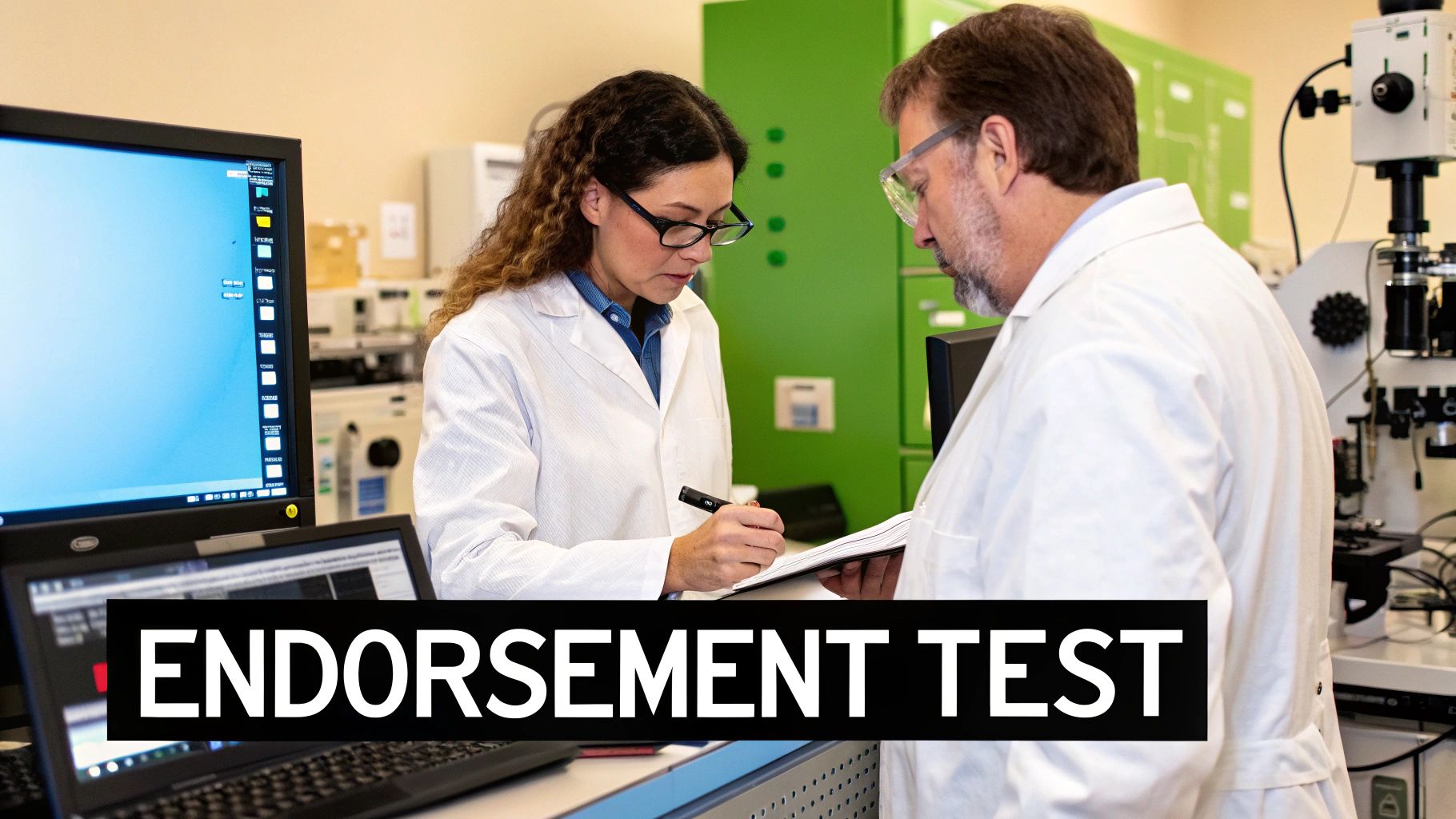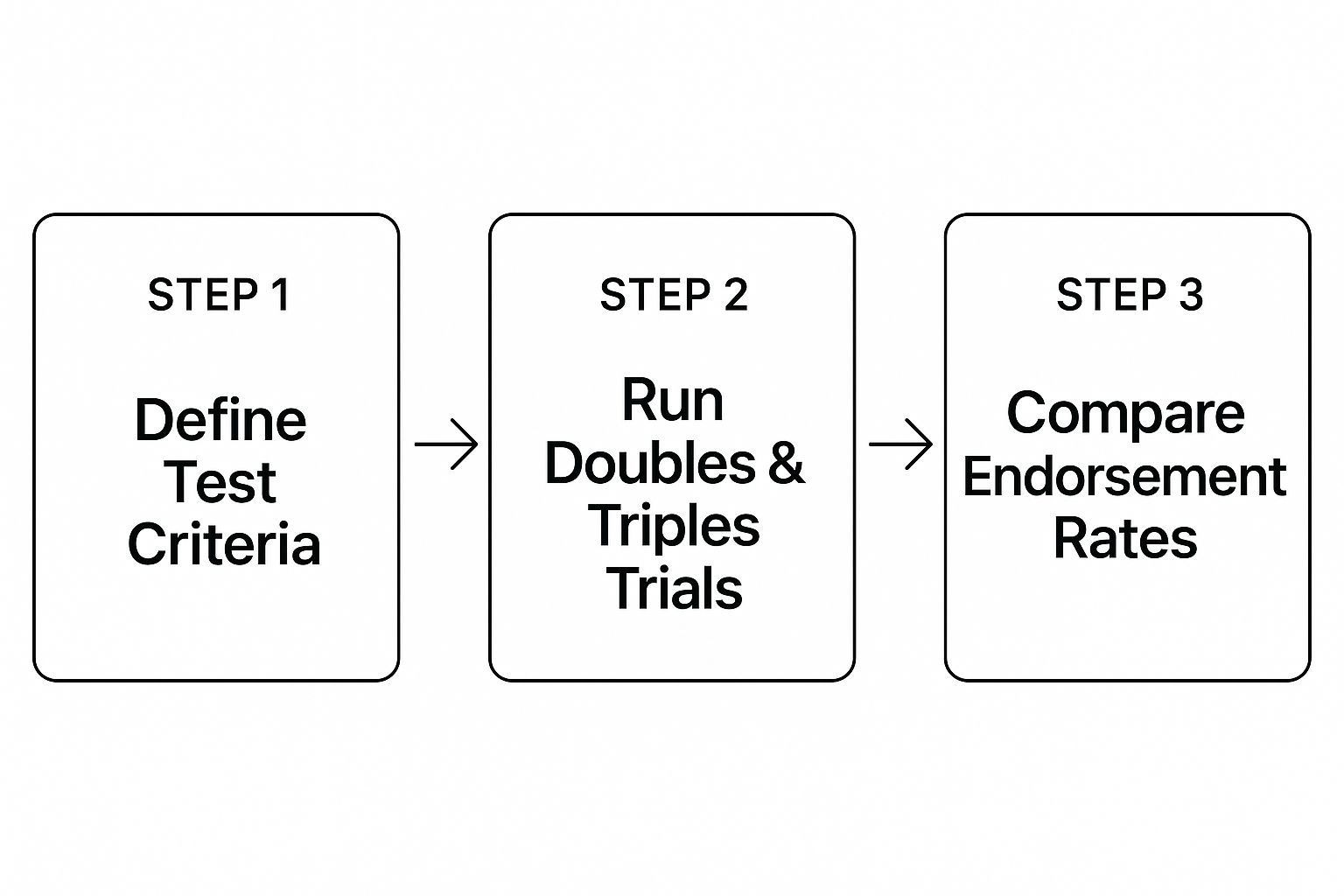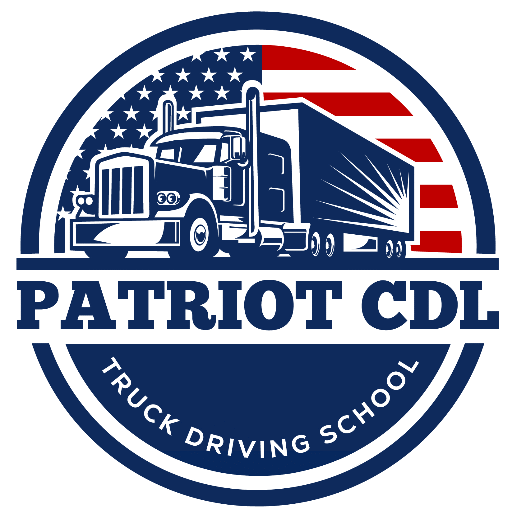So, you're thinking about adding the doubles and triples endorsement to your CDL. That's a smart move. This certification, often just called the T endorsement, is your ticket to pulling two or three trailers at once and opens the door to some of the best-paying jobs in the trucking industry.
Understanding the T Endorsement and Its Impact on Your Career

Before you hit the books, it’s worth understanding what this endorsement really means for a professional driver. It's more than just another stamp on your license; it’s a clear signal to employers that you’ve mastered a higher level of skill and knowledge. In a competitive industry, that distinction makes you a much more valuable driver.
This isn't just about bragging rights, either. It translates directly into real-world advantages. Drivers qualified to handle Longer Combination Vehicles (LCVs) are in high demand and can often negotiate better pay. For anyone aiming for a career in long-haul freight or looking to work with major logistics companies, the T endorsement isn't just an option—it’s often a must-have.
What the Test Actually Covers
Getting your T endorsement means passing a written knowledge test. You'll typically face about 20 questions and need to score at least 80% to pass. The questions are laser-focused on the unique challenges that come with hauling multiple trailers. While most states stick to the written exam, some may also require a skills test in an actual double or triple rig.
The whole point is to make sure you can safely handle the specific dynamics of LCVs. You'll need to demonstrate you have a solid grasp of:
- Coupling and Uncoupling: Getting the sequence wrong isn't an option. It's a major safety risk and can lead to costly equipment damage.
- Vehicle Stability: LCVs have a higher center of gravity and are much more prone to rolling over. You also have to contend with the infamous "crack-the-whip" effect, where the last trailer can swing out wildly.
- Handling and Braking: These rigs are incredibly long and heavy. You need to know how to manage that momentum, especially when braking or navigating turns. It's a whole different ball game.
- Inspections: Your pre-trip inspection gets more complex. You'll have extra pintle hooks, dollies, and air lines that all need a thorough check.
To give you a clearer picture, here's a quick breakdown of what the T endorsement involves.
T Endorsement at a Glance
| Component | Description |
|---|---|
| Endorsement Name | Doubles and Triples (T Endorsement) |
| Purpose | Authorizes operation of a commercial vehicle pulling two or three trailers. |
| Primary Test | A written knowledge exam, typically 20 questions. |
| Passing Score | Usually requires 80% or higher. |
| Key Topics | Coupling/uncoupling, "crack-the-whip" effect, rollover prevention, inspections. |
| Vehicle Type | Longer Combination Vehicles (LCVs). |
| Career Benefit | Access to specialized, often higher-paying, driving jobs. |
Getting this endorsement is about more than just memorizing answers for a test.
You're building the fundamental skills to safely and efficiently operate some of the biggest rigs on the road. Mastering this material sets you up for a safer, more successful, and more lucrative career.
Proven Strategies for the Written Knowledge Exam

Passing the written exam for your doubles and triples endorsement is the first real hurdle. This isn't just about rote memorization of the CDL manual. It's about getting a genuine feel for the physics and safety protocols that come with handling a Longer Combination Vehicle (LCV). A smart study plan is what builds the kind of confidence that lets you walk in ready for anything.
The drivers who really nail this test are the ones who focus on the "why" behind the rules. Don't just learn that you need more stopping distance; understand why the extra weight and length turn a routine stop into a major event. When you grasp the concepts on that level, the information really sticks.
Decoding the Toughest Test Topics
Some topics are practically guaranteed to show up on the exam because they are absolutely critical to doing this job safely. Expect a heavy focus on coupling and uncoupling procedures. The sequence is non-negotiable—getting it wrong with a dolly or connecting air lines out of order can create a dangerous situation before you've even moved an inch.
Another big one is the "crack-the-whip" effect. This is what happens when your rear-most trailer swings out with exaggerated force during a turn or a quick lane change, and it’s a primary cause of LCV rollovers. You’ll definitely see questions testing how speed and sharp steering inputs can trigger this terrifying effect.
To get yourself ready, zero in on these key areas:
- Air Brake Systems: You need to know how air pressure is managed across multiple trailers and how to properly check a much longer system for leaks.
- Rollover Prevention: Be prepared for questions on the high center of gravity in LCVs and how to handle it on curves, ramps, and uneven roads.
- Vehicle Inspection: Get familiar with the specific components you need to check on dollies, pintle hooks, and all the extra connections.
A strong foundation makes all the difference. If you feel rusty on the basics that apply to all commercial vehicles, our guide on the general knowledge test is a great place to brush up before you tackle the more complex LCV material.
Applying Knowledge to Real-World Scenarios
The best way to prepare for the doubles triples endorsement test is to start thinking like the person who wrote the questions. They want to know you can apply what you've learned to the actual situations you'll encounter out on the road. Picture yourself trying to get through a tight roundabout—how is the severe off-tracking of that last trailer going to change your path?
Think about a car suddenly cutting you off, forcing you to brake hard. How do you control the brakes to keep the rig straight and prevent the trailers from jackknifing or slamming into each other? Running through these "what if" scenarios in your head is what bridges the gap between the manual and real-life decision-making.
The real objective isn't just to pass a test; it's to start building the judgment of a professional LCV operator. Look at every practice question as a chance to prepare for a problem you might face on the highway.
Looking at recent data from various state DMVs, the pass rate for this endorsement's knowledge test hovers around 80%. The exam usually consists of 20 questions, and you'll need to get at least 16 correct to pass. While only a small percentage of CDL holders go for the T endorsement, those who do often unlock better pay and a wider range of job opportunities. Mastering this material puts you on the path to joining that group.
Mastering Your Practical Skills Test Maneuvers
While the written test is a big hurdle, some states also require a hands-on skills test for the T endorsement. If yours does, get ready to prove you can physically manage the unique challenges of a multi-trailer rig.
This isn't just about driving around the block. It’s a full-blown demonstration of precision, safety, and control. The examiner needs to see that you can handle the extra length and multiple pivot points with the confidence of a seasoned professional, not a rookie fumbling their way through. This is where the rubber meets the road—literally.
The Critical Pre-Trip Inspection
Your test starts the moment you walk up to the truck. A flawless pre-trip inspection is non-negotiable, and the examiner will be watching you like a hawk, especially when you get to the parts unique to doubles and triples.
You have to know that converter dolly inside and out. That means pointing out the pintle hook, safety chains, and all the extra air and light lines, explaining what you’re looking for. Don’t just point and mumble. You need to verbalize your process clearly. For instance, when you get to the pintle hook, you’d say you're checking that it's secure, properly latched, and free of any cracks or excessive wear. A detailed inspection shows you’re serious about safety, and it’s often the first big test you have to pass. You can get a handle on the full routine by studying up on the complete CDL pre-trip inspection process.
The visual below breaks down how the testing criteria are developed and how trial runs help establish fair endorsement standards.

This structured approach is what ensures the skills test is a true measure of a driver's ability to safely operate these LCVs.
Coupling and Uncoupling with Precision
I've seen more drivers fail on coupling and uncoupling than almost any other part of the test. The sequence of steps isn't a suggestion; it's a rigid procedure designed to prevent catastrophic failures. If you get the order wrong—like forgetting to chock the wheels or failing to test the dolly brakes—you’re done. It's an automatic fail.
Remember the golden rule: Never, ever get under a trailer until you are 100% certain it is securely supported. An examiner will be watching to see if you test your connections by giving a gentle tug against the trailer with the tractor. That simple move proves the fifth wheel and pintle hook are locked in tight.
This part of the test is all about showing you have a methodical, safety-first mindset.
Navigating Backing and Turning Maneuvers
Alright, now it’s time to move the beast. The extra pivot points on a double or triple completely change how the rig responds, and nowhere is that more obvious than when backing up. The very last trailer—the one you can barely see—has a mind of its own. It reacts with a delay and often swings out more than you'd expect, so your steering adjustments have to be small and deliberate.
When you're making turns, off-tracking is your biggest enemy. That rear trailer will cut the corner much more sharply than your tractor. Examiners are looking for a few key things here:
- Go wide. You have to swing out way wider than you would in a standard 53-footer. Give that last trailer plenty of room to clear curbs, signs, and anything else in its path.
- Live in your mirrors. Situational awareness has to be cranked to eleven. You need to know where every single one of your trailers is at all times.
- Control your speed. Smooth and slow wins the race. Trying to rush a turn is a recipe for disaster and a massive red flag for any examiner.
It takes a lot of practice to get a feel for it, but once you nail these skills, you’ll show the examiner you're truly ready for the road.
How to Navigate State-Specific LCV Regulations

Passing the doubles and triples endorsement test is a major milestone, but it's just the beginning. That "T" on your license gives you the federal qualification, but state laws are what dictate where—and if—you can actually haul these rigs.
Think of the rules for Longer Combination Vehicles (LCVs) as a complex patchwork quilt. What's perfectly legal in one state can get you pulled over, fined, and shut down the second you cross into the next. This isn't just about avoiding a ticket; it's a fundamental part of route planning that affects your safety, your schedule, and your job.
Understanding the Patchwork of LCV Laws
Right off the bat, you need to understand there's no single, nationwide rulebook for LCVs. Every state gets to call its own shots, creating a maze of regulations that can be tricky to navigate. One state might welcome triple trailers, while its neighbor only allows specific types of doubles on certain roads.
This means you have to do your homework for every single state on your route. Before you even think about firing up the engine, you need to know the specifics on:
- Overall Length Limits: While a maximum of around 120 feet is common in some areas, this number is far from universal.
- Gross Vehicle Weight: States set their own caps on total weight, which directly impacts your payload and profitability.
- Trailer Configuration: Are you pulling Rocky Mountain doubles, Turnpike doubles, or triples? The state's rules will tell you what's allowed.
Don't treat these details as optional. Getting caught with a combination that's too long or too heavy for a particular state can mean being forced to break down your set on the side of a busy highway. That’s a nightmare scenario causing massive delays and creating a serious safety risk.
Finding and Following Common Restrictions
Beyond the big three—length, weight, and configuration—you'll run into a whole host of other rules. Many states restrict LCVs to a designated network of highways. Stray off one of these approved routes, and you're in violation. You can see how detailed these rules get by looking into state-specific CDL requirements, like those for drivers in Alabama.
Time-of-day and weather restrictions are also incredibly common. It’s normal for LCVs to be banned during rush hour, on major holidays, or when conditions get dicey with high winds, snow, or ice.
Make it a habit to check the state's Department of Transportation (DOT) website before every trip. These regulations can and do change. A pre-trip check of the laws should be just as routine as checking your tire pressure. It’s all part of being a professional.
Real-World Safety: Putting Your Endorsement to the Test
Getting your doubles and triples endorsement is just the beginning. The real test starts when it's just you, the rig, and a thousand miles of highway. I can tell you from experience, piloting a Longer Combination Vehicle (LCV) is a whole different ballgame compared to a standard 53-footer. The basic physics are the same, sure, but every force is magnified, demanding a whole new level of skill and foresight.
You’re not just driving a truck anymore; you’re managing a train on wheels. Every tiny movement you make—a slight turn, a gentle tap of the brakes—sends a ripple effect all the way to that last trailer. It's a system, and you have to think of it that way.
Taming the Crack-the-Whip Effect
Every LCV driver has heard horror stories about the "crack-the-whip" effect, and for good reason. It’s the single biggest danger out there. A quick jerk of the wheel to dodge some debris can amplify down the line, causing your last trailer to swing out with enough force to flip itself over. That little correction at the steer axle becomes a massive, violent swing at the very back.
The only way to beat it is with smooth, deliberate actions. Forget about sudden moves. When you need to change lanes, start thinking about it a quarter-mile ahead. Signal early, check your mirrors a dozen times, and then ease into the lane so gradually it’s almost boring. I always tell new drivers to pretend there's a cup of hot coffee on the dash, and the goal is to get to your destination without spilling a drop.
Mastering Stopping Distances and Downgrades
You already know a standard rig takes a long time to stop. Now, add one or two more fully-loaded trailers to the mix. The stopping distance doesn't just get longer; it gets dramatically longer. You’re trying to slow down the momentum of 80,000 pounds or more, and all that weight wants to keep going forward.
This is never more true than when you're heading down a long grade. Riding your service brakes is a one-way ticket to disaster. You’ll cook them until they fade to nothing. Instead, you have to rely on your engine brake and use firm, steady "snubs" of the brakes to keep your speed in check. The goal is to hold a safe speed from the top of the hill to the bottom, not to try and slow down once you've already picked up too much steam.
A true pro with an LCV never has to slam on the brakes. Your following distance is your life insurance. That gap gives you the space you need to see a problem develop and react to it smoothly and safely.
Good braking also means knowing your air system inside and out. It has to work much harder to keep the tanks on multiple trailers charged. It's never a bad idea to brush up on the fundamentals. Taking a look at a guide on how your air brakes function can be a great refresher on what to check during your pre-trip.
Handling Nasty Weather
Weather that’s just an annoyance in a single-trailer rig can become a life-threatening situation in an LCV. High winds, in particular, are your worst enemy. The huge, flat sides of those trailers act like giant sails. A powerful crosswind can shove you right out of your lane or, in a worst-case scenario, put a trailer on its side.
When the wind starts howling, you need a plan:
- Slow it down. Speed is your enemy here. Reducing it plants you more firmly on the road and buys you precious reaction time.
- Keep both hands on the wheel. Get a firm grip and be ready to make constant, small steering corrections to fight the gusts.
- Know the danger zones. Bridges, overpasses, and wide-open plains are where the wind hits the hardest. Be extra vigilant in these areas.
If the wind gets too bad, the smartest and most professional thing you can do is park it. Shut it down and wait it out. Pushing through a dangerous situation is never, ever worth the risk. It’s that kind of judgment that separates the good drivers from the great ones.
Got Questions About the T Endorsement? We've Got Answers.
When you're gearing up for the doubles and triples endorsement test, a few questions always seem to come up. Getting straight answers from the get-go can really streamline your prep and give you the confidence you need to walk in on test day ready to go. Let's clear up some of the most common ones.
A lot of drivers first ask if they need to have experience actually pulling doubles to even qualify for the T endorsement. The answer is a clear no. You don't need any prior on-the-road experience with these rigs to take the test. The whole point of the written exam is to gauge your understanding of the rules, safety protocols, and the unique physics involved with LCVs—not your logbook hours.
What You Need (and Don't Need) to Qualify
Another point of confusion often revolves around other endorsements. Do you need to get your Hazmat or Tanker endorsement first? Nope. The T endorsement is its own credential and doesn't depend on others.
But here's the non-negotiable part: you must already have your Class A CDL. Think of the T endorsement as an add-on to your existing license, not a separate license itself.
The big takeaway here is that the process is all about knowledge. It’s designed to confirm you understand the specific safety measures required to handle longer combination vehicles—a serious responsibility out on the road.
If you're just starting out and don't even have your Class A yet, a great place to begin is by understanding the basics. You can get a solid overview of the initial requirements by learning what it takes to get your commercial learner's permit.
Test Prep and Career Impact
"Can I just study my state's CDL manual and be done with it?" That's a question we hear all the time. While the manual is your official guide and absolutely essential reading, relying on it alone is a gamble. I always tell drivers to find good practice tests. Getting a feel for the question formats and the specific wording they use on the actual exam makes a world of difference.
So, is all this extra effort worth it for your career? Absolutely. While it does mean hitting the books a little harder, earning your T endorsement makes you a much more valuable driver. It opens you up to specialized, higher-paying long-haul routes. It's a clear signal to employers that you've got an advanced skill set, and that can unlock opportunities that simply aren't available to other drivers.
At Patriot CDL, we're committed to getting you on the road to a successful career. Our expert instructors and hands-on training programs are designed to help you pass your tests and thrive as a professional driver. Start your journey today.
